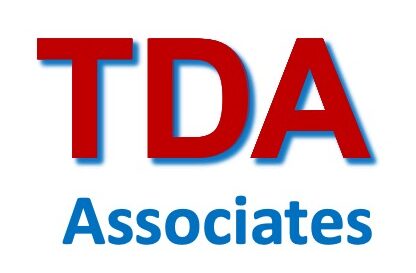Multicultural Teamwork
Course Preview
Hover Over Images Below to Learn More
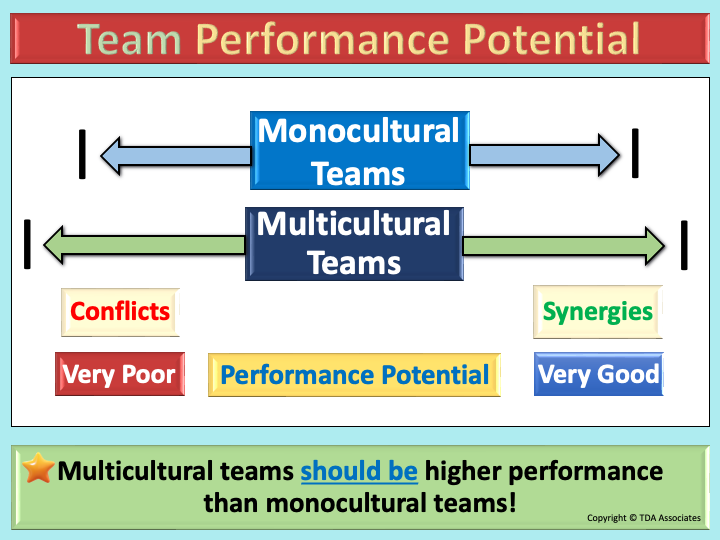
Multicultural teams should be higher performance than monocultural teams. You can achieve this performance potential by building on shared values and minimizing conflict by adapting to and leveraging the opposing values. Then, combine the best ideas into a solution and repeat this process.
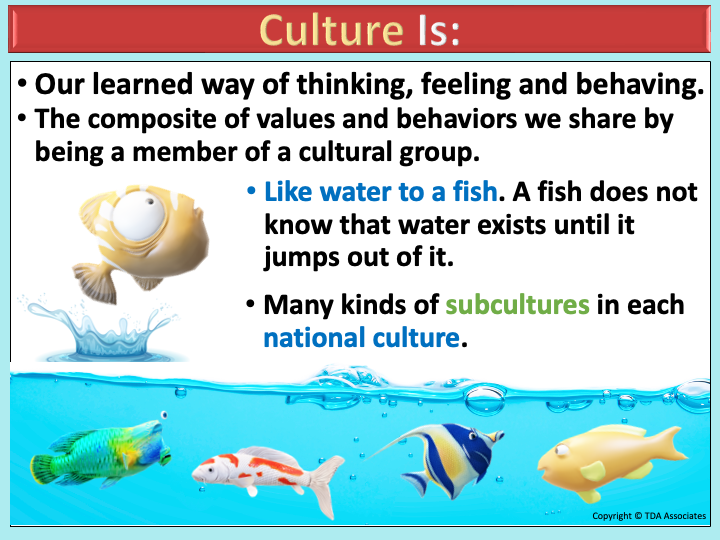
Studying "country cultural core values" is one method to understand the shared beliefs of different countries. Every individual may have slightly different values. Core values interact with and influence one another. Although core values have positive intentions they may be perceived as negative by foreigners.
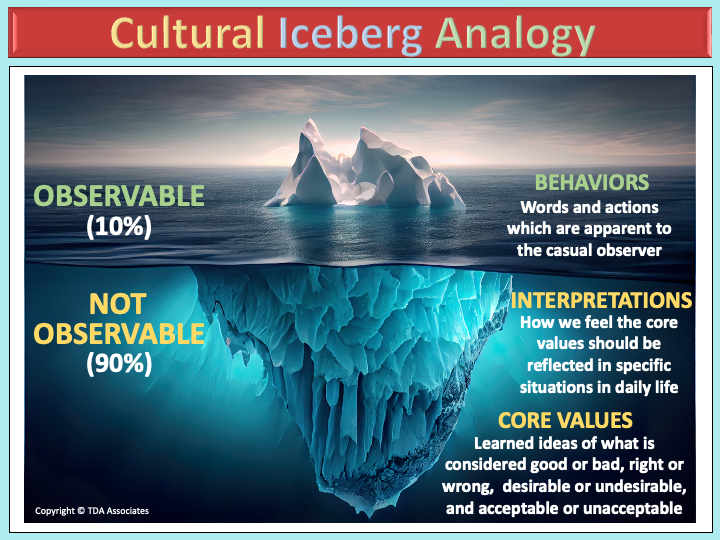
In this course, we will discuss the cultural differences in the workplace and the differences between above the service (what you see and hear) and below the surface (core values and resulting patterns of behavior and customs).
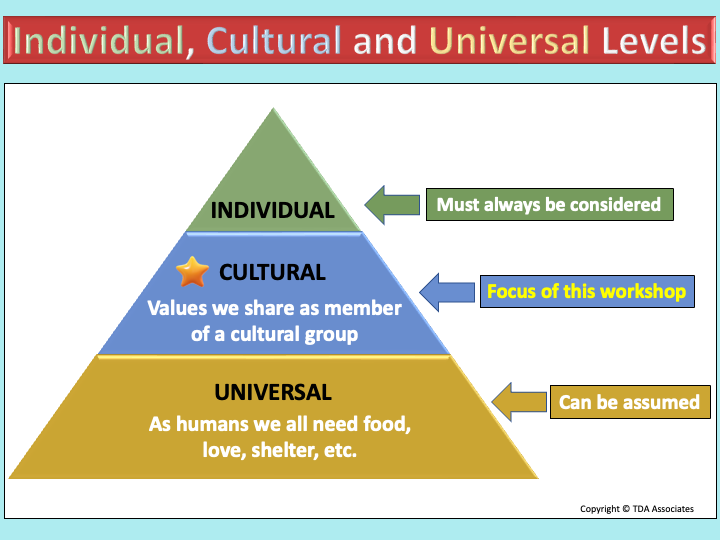
The focus of this workshop is on a cultural level, values we share as a member of a cultural group. One's cultural values and biases influences their way of thinking, communicating and acting. The core country values of other countries can be different from yours and result in misunderstanding and potential conflict. On a universal level, as human we all need food, love, shelter, etc. and this can be assumed. Also, individuals must always be considered.
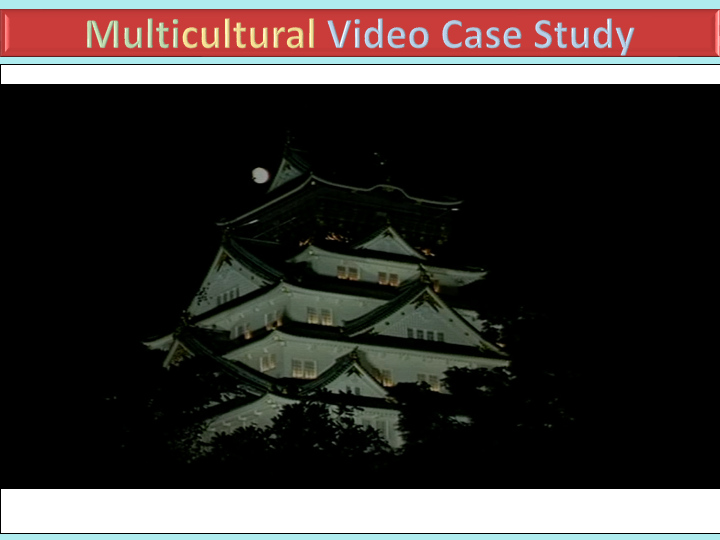
This multicultural video case study focuses on a global company team meeting demonstrating cultural team difficulties that may arise and how to overcome them.
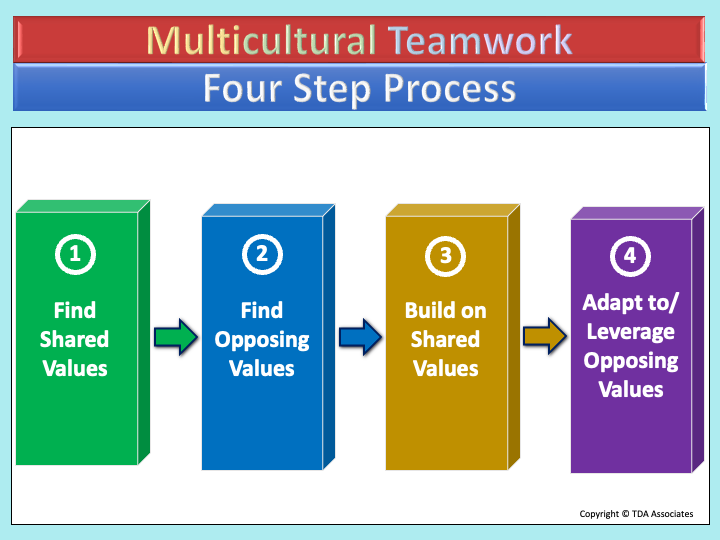
The Four Step Process is our version of multicultural teamwork using four steps of shared values, opposing values, building on shared values, and adapting to / leveraging opposing values. This process can then be repeated by choosing different countries to see what shared and opposing values they have and what possible ideas and solutions may come from it.
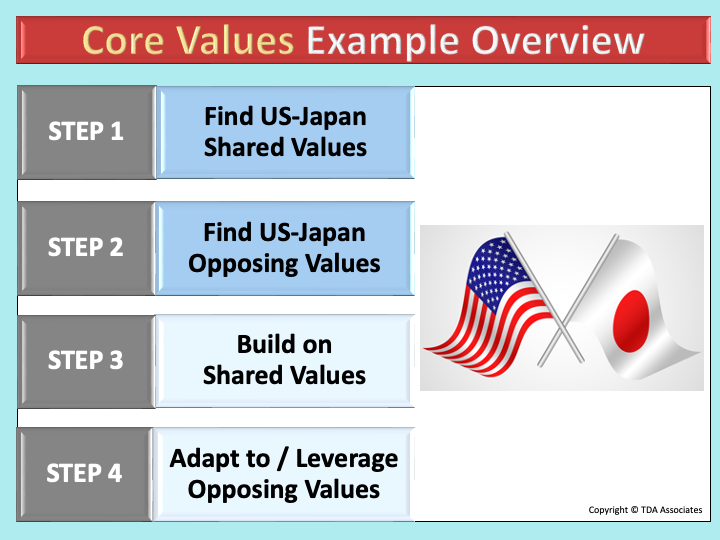
Using the four step process for multicultural teamwork we are able to compare and contrast the US and Japanese core values provided in the course.
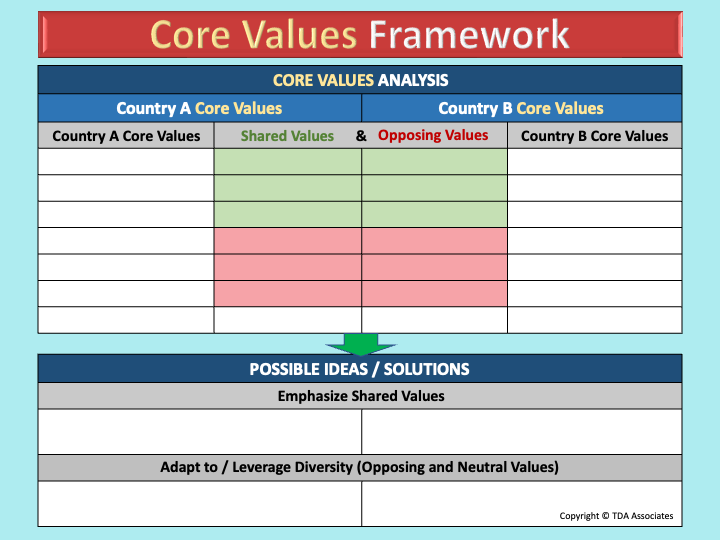
The core values framework allows for the use of core value analysis between Country A core values and Country B core values. Listing up each countries individual core values first, then comparing and contrasting to look for shared values and opposing values. Then look for possible ideas and solutions by emphasizing shared values and adapting to / leveraging opposing and neutral values.

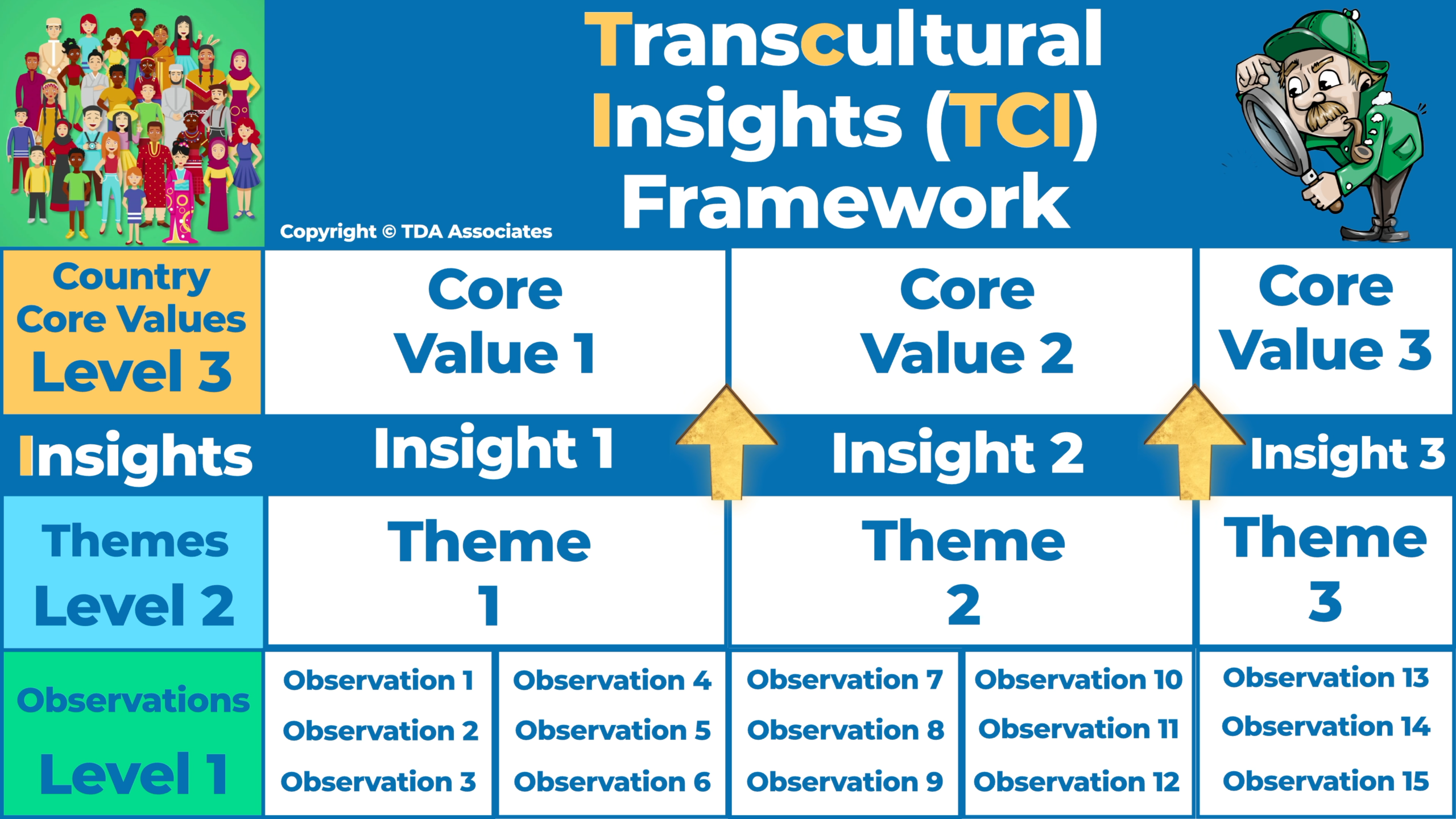
Course Outline
Course Overview
Often people working together on multicultural teams have trouble understanding why people from other cultures say or do certain things. This can create negative perceptions and expectations about these people which result in cross-cultural conflict and significantly reduced team effectiveness. This course will help participants not only understand these cultural differences, but also practice using tools that can help them work better with people from other cultures and find synergies in this diversity.
The Cultural Triple Zoom Framework introduced in this course allows participants to see cultures from Global, Country and Micro viewpoints. This approach shares different tools and research results to use for at each viewpoint level to help understand diverse cultures. Each of these tools can be chosen as appropriate and used for cross-cultural problem-solving that breaks through cultural boundaries and leverages synergies across them.
Who Should Take This Course
- Members of global teams who work regularly with people from other countries.
- Expatriates who work overseas in new cultures
- Individuals who work together with locally-based colleagues originally from other countries
- Individuals in sales, marketing, purchasing, R&D and other functions who work with overseas customers, colleagues, suppliers and other partners
- Managers who oversee overseas offices for their specific functions or business units
- Students interested in learning more about practical cross-cultural skills
- Human resource development professionals wanting to improve employees’ cross-cultural skills
Why You Should Take This Course
- Understand how your own cultural values and biases influence your way of thinking, communicating and acting.
- Learn how the core values of other countries can be different from yours and result in misunderstanding and potential conflict.
- Learn frameworks, tools and skills to analyze cultural differences at various levels and resolve cross-cultural conflicts
- Learn how to leverage team cross-cultural diversity into synergies and performance often unattainable by members from just one culture
- Bring back to your work your own personal action plan on how you will work better with your colleagues from other countries
- Get a Certificate in Multicultural Teamwork upon completion of course
What You Will Cover
Overview of the Cultural Triple Zoom Framework
Developing DIS skills for Multicultural Teamwork
- value diversity
- practice inclusion
- create synergies / solutions
Guidelines for Multicultural Teamwork and Facilitation
The Global Zoom: Cultural Dimensions
- Hofstede’s 6 Cultural Dimensions
- Trompenaar’s 7 Cultural Dimensions
- Erin Myer’s Culture Map
- The GLOBE Project Cultural Dimensions
- Cross-cultural Problem-Solving Framework using Cultural Dimensions
The Country Zoom: Country Core Values and Lifestyles
- Cultural Detective Series
- Culture Smart Series
- Cross-cultural Problem-Solving Framework using Country Core Values
The Micro Zoom: Understanding Individual Cultural Phenomena
- The Need for Deeper Cultural Understanding
- The TCI (Transcultural Insights) Methodology for Deep Cultural Code-Cracking
Personal Action Plan
How You Will Learn
- This course may be delivered in face-to-face, live online, hybrid and on-demand video formats with customized content and schedules to fit organizational needs.
- The target countries for more in-depth focus chosen are chosen by the customer
- Throughout the course the instructor provides easy-to-understand examples for each tool and ample tips on how to facilitate teams.
- The course includes extensive group practice on live problems and mini case studies using the tools introduced, with extensive instructor and peer feedback.
- The course can be delivered in English, Japanese or Portuguese.
- For live online and hybrid courses, the Miro online whiteboarding platform is used with custom templates in conjunction with Zoom (or other client-designated video conferencing platform).
- The course may be enhanced by including additional tools or further modules, for example:
- Creative problem-solving tools for numerous alternative solutions to cultural challenges
- Global leadership skills in specific markets
- Customer or market insight/foresight for specific country(-ies)
About the Instructor
Henry Andersen is a former Professor of Global Management for the MBA program at Meiji University, one of the top universities in Japan. He now teaches, though his own company TDA Associates based in the US, courses in creative problem solving, multicultural teamwork, customer insight, wise thinking skills and global wisdom leadership.
As a consultant he has helped build the innovation capabilities of organizations like Coca-Cola, Unilever, Nestle, Philips, Pfizer, the US Navy, Mazda, Mitsubishi, Toshiba, Kirin and Sumitomo on four continents.
Prior to academia and consulting, he was an international marketing, strategy and innovation executive working for companies like Sony Pictures, Mitsubishi Heavy Industries and Scott Paper (now part of Kimberly-Clark) while based in the US, Japan, Brazil, the UK and Holland.
He has a BA in Japanese from Harvard, an MS in Journalism from Columbia University and an MBA in marketing from INSEAD in France.
Andersen developed his own creative thinking methodology called transdisciplinary analogy (TDA) while working at Mitsubishi to help them solve both technical and marketing challenges they faced. He also developed the Transcultural Insights (TCI) methodology used in this course. His methodologies have been featured in the international business press, academic publications, and in a number of books on creativity and innovation published in over six languages.
